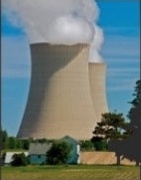Sue Sturgis/Facing South
In the decade after the meltdown at Pennsylvania’s Three Mile Island nuclear power plant, which took place 40 years ago this week, number of nuclear plant orders that U.S. utilities canceled nationwide amid skyrocketing costs: about 100
In today’s dollars, estimated amount those abandoned plants cost taxpayers and ratepayers: over $40 billion
Amount ratepayers shouldered in cost overruns alone for the approximately 100 nuclear power plants built around that time: over $200 billion
Year in which Forbes magazine called the U.S. nuclear power program “the largest managerial disaster in business history, a disaster on a monumental scale”: 1985
Year in which the nuclear power industry began using the term “nuclear renaissance” to hype a hoped-for revival of reactor construction: 2001
Between 2007 and 2009, number of applications for new reactor construction projects submitted to the U.S. Nuclear Regulatory Commission by utility companies: 18
Of those proposed projects, number that were in the South, where electricity markets are dominated by the monopoly utility model with guaranteed profits, and where some states allow utilities to force customers to pay in advance for construction projects: 13
Of the 18 proposed reactor projects, number that are still proceeding today, with others canceled amid skyrocketing costs driven in part by the 2011 Fukushima Daiichi nuclear power plant disaster in Japan: 1
[…]
Amount South Carolina ratepayers must pay for SCE&G’s and Santee Cooper’s now-canceled project involving construction of two new reactors at the Summer plant in Fairfield County: $2.3 billion
Number of powerful 5 kilowatt home solar electric systems that could be installed with $2.3 billion: more than 65,000
Initial cost estimate for the one commercial nuclear project that’s still proceeding, Georgia Power’s construction of two reactors at Plant Vogtle in Burke County: $14 billion
Current cost estimate for the Vogtle project, now set to finish in 2022: over $27 billion
Because of Georgia’s nuclear prepayment law, approximate amount the Vogtle project has already added to the average annual Georgia Power electricity bill: $120
Year in which Democrats angered by the prepayment scheme’s economic injustice and Republicans upset over its violation of free-market principles united in Georgia’s legislature to quash similar deals for any other commercial reactors built in the state: 2018
Amount in additional taxpayer-backed federal loan guarantees that were announced for the Vogtle project last week amid a visit to the plant by U.S. Energy Secretary Rick Perry, who called it “the real new green deal”: up to $3.7 billion
Total amount in federal loan guarantees the Vogtle project has received to date: $12 billion
Article here.
Read more.




